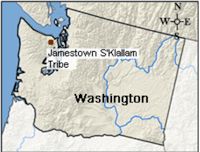The Jamestown S’Klallam Tribe is a federally recognized Salish indian tribe that resides on the northeastern portion of the Olympic Peninsula, in northwestern Washington.
Official Tribal Name: Jamestown S’Klallam Tribe of Washington
 Address: S’Klallam Tribe,1033 Old Blyn Hwy, Sequim, WA 98382
Address: S’Klallam Tribe,1033 Old Blyn Hwy, Sequim, WA 98382
Phone: 360-683-1109
Fax:
Email: Contact Form
Official Website: www.jamestowntribe.org
Recognition Status: Federally Recognized
Traditional Name / Traditional Meaning:
S’Klallam – meaning “strong people.”
Common Name / Meaning of Common Name:
Alternate names / Alternate spellings / Misspellings:
Formerly known as the Jamestown S’Klallam Tribe of Washington.
Clallam, Klallam, S’Klallam
Name in other languages:
Region: Pacific Coast
State(s) Today: Washington
Traditional Territory:
The S’Kallam have lived on the Olympic Peninsula in the State of Washington for at least 10,000 years. They were first contacted by Europeans in 1790.
Confederacy: Salish
Treaties:
Point No Point Treaty with the U.S. in 1855
Reservation: Jamestown S’Klallam Reservation and Off-Reservation Trust Land
Land Area:
Tribal Headquarters:
Time Zone:
Population at Contact:
Population in 1855 was about 100.
Registered Population Today:
Tribal Enrollment Requirements:
Genealogy Resources:
Government:
Charter:
Name of Governing Body:
Number of Council members:
Dates of Constitutional amendments:
Number of Executive Officers:
Elections:
Language Classification:
Language Dialects:
Number of fluent Speakers:
Dictionary:
Origins:
Bands, Gens, and Clans
Related Tribes:
The Lower Elwha Klallam Tribe is one of the four Klallam tribes. Three are based in the Pacific Northwest of the United States and one in British Columbia, Canada. There are also Klallam people on several other reservations in the US. They are also related to the Sook and other Tribes of British Columbia, and to most of the Tribes of the Puget Sound Area.
- Confederated Tribes of the Chehalis Reservation (Upper and Lower Chehalis, Klallam, Muckleshoot, Nisqually, and Quinault)
- Lower Elwha Tribal Community (Klallam)
- Jamestown S’Klallam Tribe (Klallam)
- Muckleshoot Indian Tribe (Muckleshoot, Dothliuk, Duwamish, Lushootseed, Skopamish, Smulkamish / Smalhkamish, Snoqualmie, Stkamish / Skekomish, Tkwakwamish / T’Qua-qua-mish, Upper Puyallup, and Yilalkoamish)
- Nisqually Indian Tribe (Nisqually)
- Port Gamble S’Klallam Tribe (Klallam)
- Quinault Indian Nation (Quinault, Queets, Quileute, Hoh, Chehalis, Chinook, and Cowlitz)
- Scia’new First Nation (Becher Bay Indian Band or Beecher Bay Indian Band), (Becher Bay Indian Reserve No. 1, Becher Bay Indian Reserve No. 2, Fraser Island Indian Reserve No. 6, Lamb Island Indian Reserve No. 5, Long Neck Island Indian Reserve No. 9, Twin Island Indian Reserve No. 1, Village Island Indian Reserve No. 7, and Whale Island Indian Reserve No. 8), Vancouver Island, British Columbia
Traditional Allies:
Traditional Enemies:
Ceremonies / Dances:
Modern Day Events & Tourism:
Legends / Oral Stories:
Art & Crafts:
Animals:
Clothing:
Housing:
Subsistance:
Economy Today:
Religion & Spiritual Beliefs:
Burial Customs:
Wedding Customs
Radio:
Newspapers:
Famous Salish (Jamestown S’Klallam) Chiefs and Leaders:
Catastrophic Events:
Tribe History:
With the signing of the Treaty of Point No Point in 1855, came provisions for a payment of $60,000 to the signatory Tribes payable over 20 years (with no indicated means of distribution), and the right to fish at their “usual and accustomed places.” A reservation was established at Skokomish, however the Tribes did not have a friendly relationship and the S’Klallams attempted to remain near their traditional fishing areas.
After 1870, white settlers in Washington Territory began to bring pressure upon the Bureau of Indian Affairs to move all treaty Indians to reservations. Many of the Indians merely squatted on the land, and without a clear title, were easily and frequently dispossessed.
By 1874, a band of S’Klallams under the leadership of Lord James Balch, whose father had signed the 1855 treaty, raised enough money to pay $500 in gold coin for a 210-acre tract near Dungeness, Washington Territory. This began the Jamestown S’Klallam community. The Tribe supported itself by gardening, fishing and working in the surrounding pulp mills.
During the Indian Reorganization Act period (1935-1939), the Jamestown S’Klallams were nearly organized as part of a larger S’Klallam Tribe. Since land had already been purchased for two other S’Klallam Tribes, the Jamestown S’Klallams were given the choice of moving to another reservation or staying where they were and remaining unrecognized. They chose the latter rather than giving up the land they purchased themselves and losing a great deal of the independence they worked so hard to preserve.
The Jamestown S’Klallams received services from the Federal government until 1953, when the government no longer “recognized” them. However, the Tribe maintained a considerable cohesion, and have been recognized as a distinct community by other S’Klallam groups and other Washington Indians. Characterized as a “progressive” Indian community, Tribal citizens sought new educational opportunities and aggressively integrated into the non-Indian community and its economy.
A major factor in the stability and continuity of the Tribe was the land base purchased when it was formed in 1874. This provided a geographical center for group identity and independence.
In the 1970’s, the mood of the Jamestown Tribal membership changed as it saw that fishing and hunting rights were denied them due to the lack of federal recognition. Because of overall economic conditions, the membership also became aware of the difficulty in providing for health and educational care. The Tribe soon realized that only through Federal recognition would they be able to provide for these basic needs. This effort began around 1974 and was established after a long struggle on February 10, 1981.
In the News:
Further Reading:

